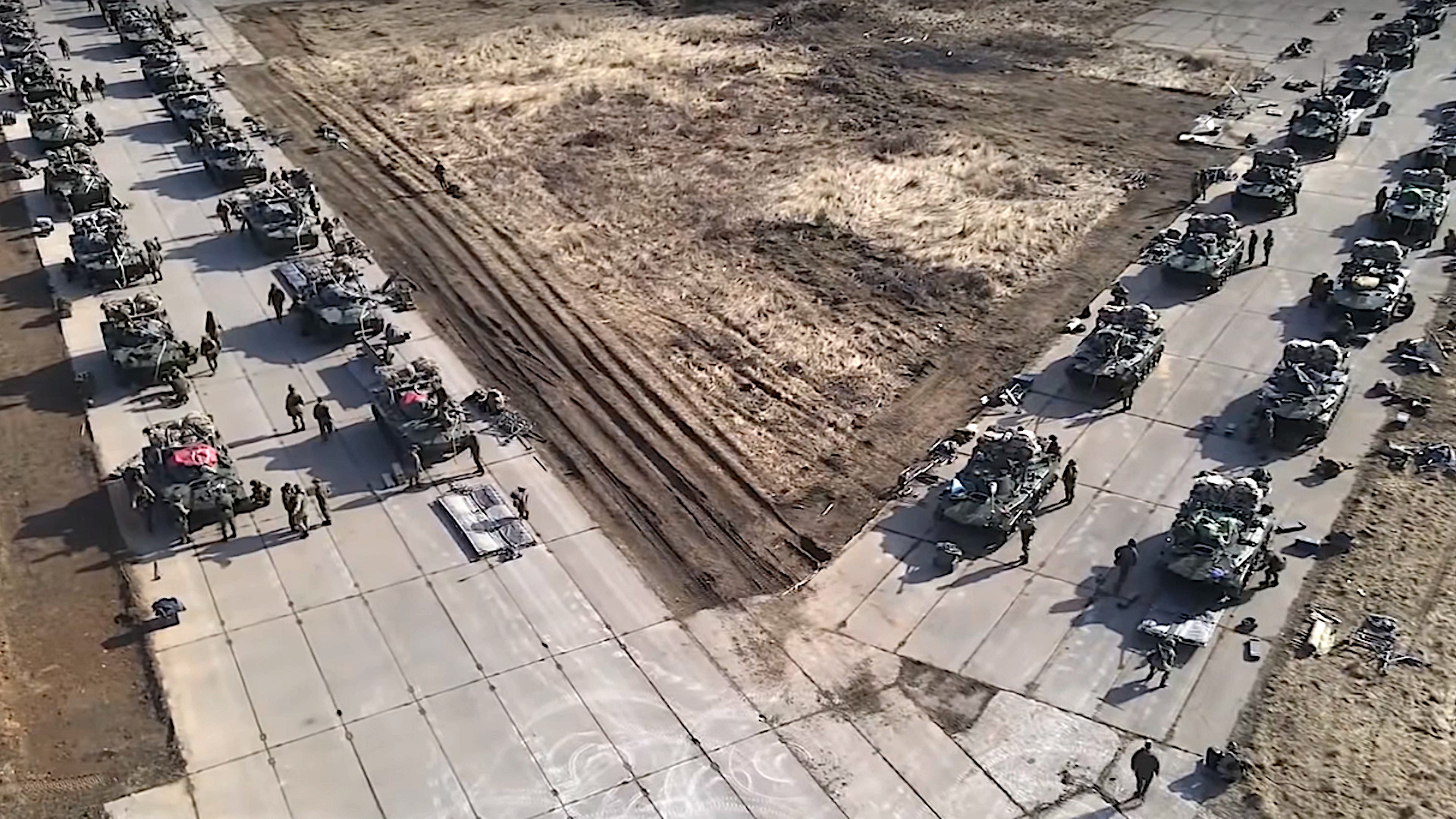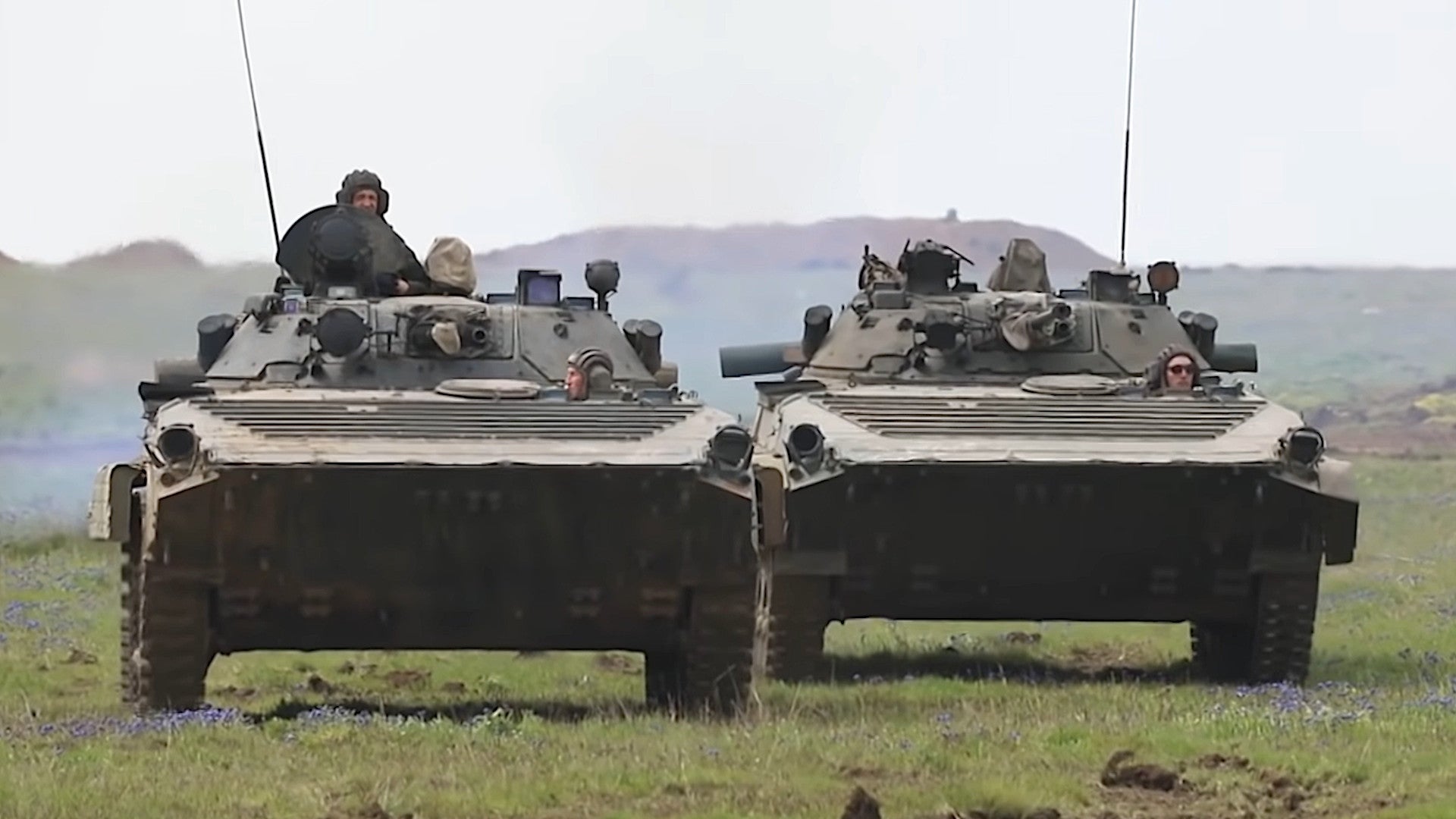Russian Defense Ministry Sergei Shoigu has said the worrying troop buildup in areas along Russia’s borders with Ukraine will come to end, starting tomorrow, with the bulk of the forces returning to their home stations. However, it remains to be seen what this drawdown will actually amount to, especially when considering previous Russian pronouncements regarding troop withdrawals. At least some of these forces already set to remain permanently in the Crimea region. Significant stockpiles of heavy weapons, including tanks, self-propelled howitzers, rocket artillery systems, and Iskander-M short-range ballistic missiles, will also stay where they are in southwestern Russia, too. This is ostensibly to keep them prepositioned for a major exercise in the fall, but would also keep them in place near Ukraine should a new crisis erupt.
Shoigu announced the successful end of what Russian authorities had officially described as a major readiness exercise during a meeting with other officials in Crimea, with the press in attendance, on April 22, 2021. The buildup had begun in March and had prompted concerns, including from the United States and NATO, that a new crisis between Russia and Ukraine was imminent. The two countries have been engaged in something of shadow war since 2014, when the Kremlin took control of Crimea and then began actively supporting nominally local “separatists” in areas of eastern Ukraine known collectively as the Donbass. The separatist groups have direct links, to Russian intelligence agencies and their forces are bolstered by actual Russian military units.

“I believe that the surprise inspection’s goals have been achieved in full,” Shoigu said. “The troops demonstrated ability to reliably defend the country. Therefore, I have made a decision to complete the inspection measures in the Southern and Western Military Districts.”
“The reduction of troops on our border proportionally reduces tension. [Ukraine] is always vigilant, yet welcomes any steps to decrease the military presence & deescalate the situation in Donbas,” Ukrainian President Volodymyr Zelensky, who had recently challenged his Russian counterpart Vladimir Putin to meet him face-to-face in eastern Ukraine, writing on Twitter. “Ukraine seeks peace. Grateful to international partners for their support.”
The exact size and scope of the Russian buildup near Ukraine remain unclear. The Russian Ministry of Defense said that more than 10,000 troops, 40 warships, and 1,200 “units of equipment,” typically a reference to tanks and other heavy weapons, had taken part in recent exercises specifically in and around Crimea. Footage of these drills that the Russian Ministry of Defense released, along with other videos that emerged online, show a full spectrum of capabilities involving forces on land, in the air, and in the Black Sea.

Airborne forces conducted parachute drops, including of BMD-series air-droppable infantry fighting vehicles, while other troops conducted helicopter-borne air assaults, the latter tactic being an important component of how Russian took control of Crimea seven years ago. Naval forces conducted landing exercises that involved various kinds of amphibious warfare vessels, including Serna class landing craft that had come all the way from the Caspian Sea. Various tanks and self-propelled artillery systems also participated in the drills.
Su-24 Fencer swing-wing combat jets and Su-30 fighters also took part, with the latter being show armed with Kh-31 anti-ship missiles. Those aircraft, combined with the anti-ship missile capabilities found in the ships and submarines of the Russian Navy’s Black Sea Fleet, as well as the Bal and Bastion-P shore-based anti-ship missile systems in Crimea, underscore the significant capabilities that the Russians can bring to bear to fend off any attempt to storm the Peninsula by sea. Tor-M2 surface-to-air missile systems were also seen in the footage. It’s not clear if any of the longer-range air defenses Russia has deployed to Crimea since 2014, which include S-400 SAM batteries and that form an additional component of the country’s significant anti-access and area denial bubble in the region, directly took part in the exercises.
It’s also interesting to note that at least one Orion drone, a rough equivalent to the U.S. MQ-1 Predator that can carry various small munitions and that Russians say they have field tested in Syria, also made an appearance.
However, these drills, which are similar to ones that have occurred in the past, are just one facet of the Russian military buildup near Ukraine. Earlier this week, Josep Borrell, the European Union’s (EU) top foreign policy official had said that, since March, it was estimated that over 150,000 Russian troops had been deployed to the country’s southwestern regions, as a whole. EU officials subsequently revised that figure downward to over 100,000.
Not all of these units are now heading back to their main bases. Three divisions from Russia’s Airborne Forces, commonly referred to by the acronym VDV, as well as one field army each from the Central and Southern Military Districts, were the only units that the Russian Ministry Defense specifically identified as preparing to leave the region. There does not appear any word yet about what might happen to any of the air or naval assets that have flooded into the region in the past month or so. It has already been announced that the VDV’s 56th Guards Air Assault Brigade will be reformed into a separate regiment based in Crimea proper, as well.
Beyond that, Shoigu made clear that the actual equipment belonging to the Central Military District’s 41st Army would remain in a massive camp established at the Pogonovo Training Area, south of the Russian city of Voronezh, which lies less than 120 miles from the Ukrainian border. Satellite imagery, together with video and pictures that have emerged online in the past few weeks, shows that there are significant numbers of tanks, self-propelled howitzers, artillery rocket launchers, and Iskander-M short-range ballistic missiles, among other assets, now parked Pogonovo.
The stated reason for this is to avoid having to bring all this equipment back for the 2021 iteration of the Zapad exercise, a huge training event that Russia holds every four years across the western portion of the country together with forces from neighboring Belarus. Of course, this also means that troops could be rushed back to the area before then to join this prepositioned stockpile should a new Russia-Ukraine crisis emerge.
This latest buildup had already included forces previously deployed to the region for exercises, which had remained there after those drills had wrapped up. That unexpected development was among the factors that had prompted concerns about the true intentions of what the Kremlin only later publicly claimed was a part of a “surprise inspection” of the readiness of various units across the country.
It’s also unclear whether Shoigu’s declaration that the recent drills were a success and are now over means that the Russian government’s plans to wall off a significant portion of the northeastern Black Sea, effectively blocking access to critical ports in eastern Ukraine, for the next six months would still go into effect. This would include the Kerch Strait, which links to the Sea of Azov to the rest of the Black Sea and was the site of a major altercation between Russian and Ukrainian forces in 2018. Russia detained 23 Ukrainian sailors and seizing a number of small vessels belonging to Ukraine’s Navy in what became a major international incident that also sparked fears of more open conflict between the two countries.

If nothing has changed, these new maritime restrictions, which had been linked to unspecified naval exercises, will begin on April 24 and run through October 31. Russia had also curtailed access to certain airspace in the region in relation to the recent drills in Crimea, but it’s not clear if those restrictions are still in place.
“This represents yet another unprovoked escalation in Moscow’s ongoing campaign to undermine and destabilize Ukraine,” State Department spokesperson Ned Price had said in a statement on April 19. “This development is particularly troubling amid credible reports of Russian troop buildup in occupied Crimea and around Ukraine’s borders, now at levels not seen since Russia’s invasion in 2014, and other provocative actions by Russia-led forces at the Line of Contact [in the Donbass].”
NATO and the EU also criticized the planned restrictions.
On top of all this, fighting has recently spiked in the Donbass and a water crisis in Crimea remains unresolved. It had been posited that one of the driving factors behind Russia’s recent buildup might have been to coerce Ukraine somehow into supplying water to the peninsula, something it has refused to do since 2014, or to simply provoke a conflict in which it could occupy new territory and physically gain access to additional sources of freshwater. All told, there are still significant underlying issues that could easily lead to a new crisis between the two countries.
“I hope that no one will think of crossing the red line with Russia. And where this line will be, in every particular case, we will determine it ourselves,” Russian President Vladimir Putin warned, somewhat cryptically, in his annual state-of-the-nation address yesterday.
“We want good relations…and really don’t want to burn bridges,” he continued. “But if someone mistakes our good intentions for indifference or weakness and intends to burn down or even blow up these bridges, they should know that Russia’s response will be asymmetrical, swift, and harsh.”
The Russian government, and Putin in particular, is facing an unusually strong wave of pressure, both on the international stage and domestically, in no small part over the fate of Alexei Navalny. Navalny, a long-time critic of Putin’s and general anti-corruption activist, who survived an assassination attempt by the Kremlin last year, is now in a potentially life-threatening state in a Russian prison. He was convicted of numerous charges, which he and his lawyers have decried as politically motivated, earlier this year and went on hunger strike over his imprisonment last month. His health has since deteriorated dramatically, drawing criticism and concern from multiple countries, including the United States, which has said the Kremlin will be held accountable if he dies.
The U.S. government also recently expelled a number of Russian diplomats in retaliation for Russian government interference in the 2020 U.S. presidential election and a massive cybersecurity breach that impacted numerous American government agencies. The government of Czechia did the same just days ago after establishing links between a unit of the Russian Military’s Main Directorate intelligence agency, more commonly known as the GRU, and a mysterious explosion at military munitions warehouse in 2014. This same unit has been implicated in numerous assassinations and assassination attempts, including the attempt to kill Navalny in 2020.
A crisis with Ukraine, now or in the future, could simply offer a way to distract from all of this, too.
With all this in mind, it’s certainly a hopeful development that Russia says it will pull at least some its forces currently positioned along its border with Ukraine. Regardless, Russia’s actual actions show that it is fully prepared to go right back to this near-crisis state, and do so quickly, if and when it feels doing so would be in its interests.
All told, only time will tell just how much of a drawdown the Kremlin will actually carry out.
Contact the author: joe@thedrive.com
